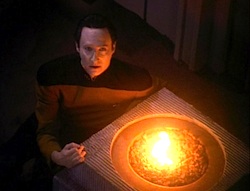“Masks”
Written by Joe Menosky
Directed by Robert Wiemer
Season 7, Episode 17
Production episode 40276-269
Original air date: February 21, 1994
Stardate: 47615.2
Captain’s Log: Troi is guest teaching an art class, where the students are making sculptures that represent their feelings. Data is also in the class, oddly, and after he sculpts a perfect padd, Troi challenges him to sculpt music. He makes a G-clef, which Troi figures is a good start.
The Enterprise has found a rogue comet. As Data examines it, the Enterprise is hit with a bright light, which Data figures is a sensor echo. Meanwhile, Crusher and Troi stop by the latter’s quarters en route to the morning mok’bara class only to find a mini-obelisk that Troi has never seen before. They don’t think anything of it, at first, as they’re running late; Crusher theorizes it’s from a secret admirer.
Later, back in the classroom, Data has sculpted a mask that has a marking on it similar to that of the obelisk in Troi’s cabin. They soon discover that similar symbols are just showing up on computer displays. Something has been inserted into the computer core. Data recognizes the symbols, but he has no idea from where—he is able to translate the symbols, much to his surprise.
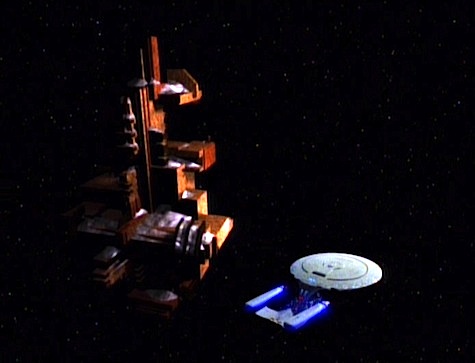
Phasers burn away the comet’s surface to reveal an object of some kind, and it’s definitely transmitting information into the sensors and replicators. Data has an intuitive understanding of it all, which has everyone concerned that he’s as compromised as the Enterprise computers. By the same token, this may be the device’s way of communicating, and this could even be a first contact, so they approach things cautiously.
The replicator starts producing many more objects like the ones Troi found in her quarters. Picard is collecting them in his ready room, and he theorizes to Riker that these have cultural significance, and that what they found could be an alien library of some sort.
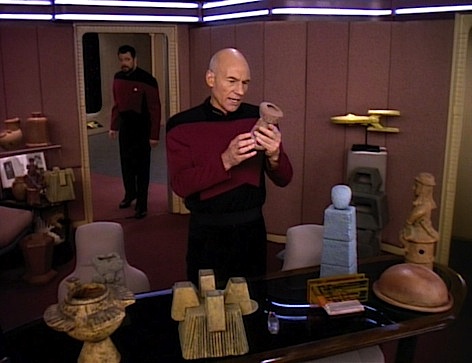
La Forge examines Data’s positronic brain, but after they finish, Data has one of the symbols from the library etched on his forehead, and his voice has changed. “Masaka is waking,” he declares, and then sits on the warp core until Picard shows up. Data identifies himself as Ihat, and now has another symbol on his chest. Picard’s attempts to question Ihat are stymied by his impish nature. But when Troi walks in, Data takes on a different personality (the symbol on his chest having changed) and kneels before her, identifying her as Masaka and saying he’s hers.
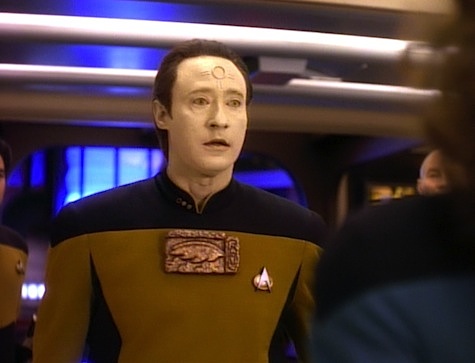
Picard confines Data to quarters. La Forge theorizes that the library is placing multiple personalities into Data’s positronic brain. Picard goes to Data’s quarters, and talks with several different people—the chest symbol changing each time—one of whom is scared to death of Masaka.
The library hits the ship with a tractor beam, cutting power to the ship. Ten-Forward has been transformed into an altar of some kind—and other parts of the ship are being changed as well. The library is somehow altering matter, changing the ship into something else piece by piece.
While La Forge attempts a technical solution, Picard tries a diplomatic one. He wishes to talk to Masaka, so he goes to Data’s quarters, where he’s channeling Masaka’s father, an elderly gentleman clutching a lit brazier. Data pings back and forth among three different personalities—Ihat, Masaka’s father, and the scared one—but he learns how to summon Masaka: building her temple. La Forge technobabbles his way into sending the symbol Data showed Picard into the transformation program on the library, which changes an entire deck into Masaka’s temple.
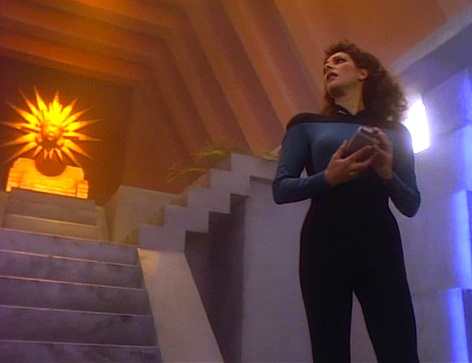
Ihat told Picard that Korgano is the only one who can control Masaka. Picard, Troi, and Worf try to find the symbol that they think represents Korgano in the temple—which Picard has actually seen all over in small form amongst other symbols. As they do so, Data puts on the mask that he made in Troi’s class, takes down the two security guards posted to his quarters (seriously, why were the two guards so utterly unprepared to deal with him? it’s not like his sooooper android speed and strength is a big secret), and then shows up in the temple. He is now Masaka, but will not listen to anyone. La Forge finds the one instance of Korgano’s symbol by itself and plugs it into the transformation program, which provides them with another mask.
Picard puts the mask on and bluffs his way through being Korgano to confront Masaka, which does the trick, changing the ship and Data back to normal. Data feels oddly empty, as there were thousands of personalities inside him—but he still has the clay mask he made, which he has painted and kept as a memento of the incident.

Can’t We Just Reverse the Polarity?: The library somehow transforms parts of the ship into stone artifacts, masks, symbols, and, at one point, an entire deck into a temple that has a higher ceiling than the deck itself, and manages to do this without transforming the outside of the ship, nor altering life support or the structural integrity field or even the configuration of the ship, which is utterly miraculous.
Thank You, Counselor Obvious: Troi guest teaches a sculpture class where she tries to get people to sculpt what they’re feeling. She tells Eric, one of the kids, to go less for realism in his bird sculpture and more to convey the feeling of flying with what he creates. Similarly, she tries to get Data (whose presence in a class filled with little kids is never explained) to sculpt music, a concept the literal-minded android struggles with at first.
If I Only Had a Brain…: As an artificial life form, Data is the perfect repository for the personalities stored in the library, though he only channels four of them outwardly. Oddly, no parallel is drawn between that and the journals of the colonists of Omicron Theta that he also has downloaded into his positronic brain….
There is No Honor in Being Pummeled: Worf aids Troi and Picard in trying to figure out the symbology of the temple. He also immediately calls for the transporter when he and La Forge are trapped in engineering, and just generally is refreshingly competent in this episode. The same cannot be said for the two people he assigns to guard Data….
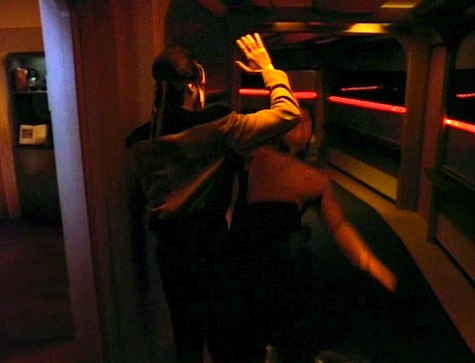
I Believe I Said That: “Worf says he’s gonna teach us some mok’bara throwing techniques today.”
“More like falling techniques. Last time we did that, I was sore for a week.”
Crusher and Troi dreading Worf’s class.
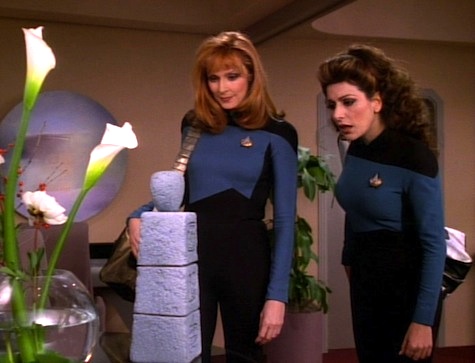
Welcome Aboard: This is the only TNG episode that has nobody listed in the guest credits whatsoever, jumping straight from the title to Peter Lauritson’s associate producer credit. The only guest is Rickey D’Shon Collins, who does a nice job with his brief role as one of the kids in the sculpting class.
Trivial Matters: The script was based on a concept Michael Piller had had to do a science fictional version of the Library of Alexandria. Menosky’s first draft had used archetypal forms, but that proved hard to do on television, so he went with actual characters. Menosky had left the staff of TNG at this point and was living in Europe, so Naren Shankar did an uncredited polish on the script.
Make it So: “Masaka is waking.” For the second week in a row, we have a Data showcase episode that I had no memory of. In fact, I had absolutely no recollection of any part of this episode, not even fleeting impressions, leading me to wonder if I ever watched it. In any case, this was a rare case of an episode that was more of a watch than a rewatch.

Joe Menosky is the guy, you’ll recall, who wrote “Darmok,” and his resumé has plenty of other stories that deal with symbology and archaeology and odd ways of communicating, often via possession of some kind (e.g. “Clues,” “Interface,” Deep Space Nine’s “Dramatis Personae”). This story is, in many ways, vintage Menosky, and it’s a delightful idea.
Unfortunately, the execution is a total disaster. I can—barely—suspend my disbelief that this millennia-old (at least) computer can effect full transformations of matter, but that it can do so to a spacefaring ship without causing any permanent damage cuts off my disbelief’s air supply. How is nobody killed or even hurt? How is the ship not damaged, except to plot-convenient parts of it?
I might be willing to forgive it if other elements were more compelling, but beyond the (very) vague archaeological fascination and Brent Spiner mugging for the camera, there’s not much to hang one’s interest on. Plus, that very lack of damage drains the suspense from it, because it eliminates the feeling of any danger. Adding insult to injury, the episode is oddly empty. When Worf checks the disturbance in Ten-Forward, there are only two people in the ship’s bar, which is impossible to believe. Worse, when La Forge and Worf are in engineering trying and failing to modify a torpedo, they’re the only ones there, and then when the senior staff has their meeting in the bridge thanks to the observation lounge being turned into a swamp, there’s nobody else on the bridge, which makes no sense. Where is everybody?
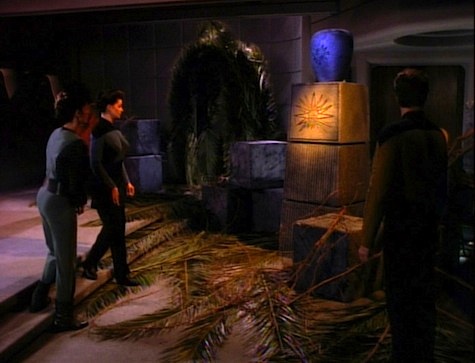
And again, this might all be forgiveable if the performances were strong, but this is a rare instance of Spiner letting us down. Putting this episode right after “Thine Own Self” is problematic enough from a story perspective—hey, look, Data isn’t himself again!—but Spiner himself has said that he had inadequate time to dig into these four new roles he was playing all at once after such a hefty amount of screen time in “Thine Own Self,” and it shows. He gives us caricatures rather than characters, really only scratching the surface. Of course, if these are supposed to be mythical, archetypal characters, surface characterization makes sense on the face of it, but that still gives us a performance—or, really, four performances—that are inadequate to watch on a TV episode.
It’s frustrating, because the concept behind this episode is an excellent one. But concepts ain’t stories, and as a story, this one fails.
Warp factor rating: 4
Keith R.A. DeCandido has two new books out, neither of which are actually SF/F: the novel Leverage: The Zoo Job, based on the TV series about criminals who help people, and the baseball book In the Dugout: Yankees 2013, which he co-edited with Cecilia M. Tan, all about New York’s American League baseball team.










